|
|
|
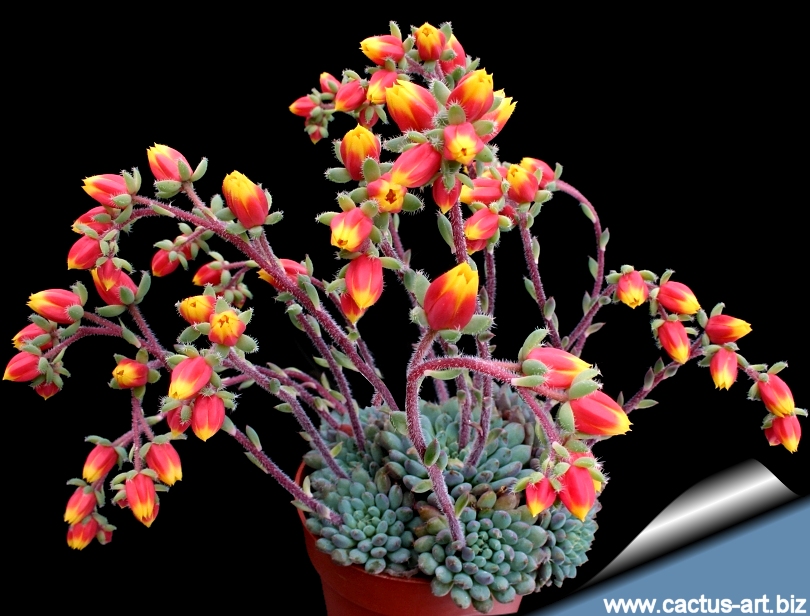
Echeveria setosa var.
deminuta
This plant has been in cultivation for some
time as “E. rundelii”, or “E. tundelii”, popular also as
"Firecracker Plant” it quickly attract the attention of visitors. When a
mature clump of perhaps a dozen or more rosettes has formed, the sight
of it in bloom easily elicits thoughts of fireworks.
|
Description
(standard form): E. setosa is a very distinct
echeveria, with a remarkable pubescence. It is a very variable slowly
clustering rosette succulent freely giving off offsets from the base and
readily forming dense mounds. Many variety and cultivars - often quite
different at a first glance - are nowadays available in cultivation.
Stem: Almost stemless.
Rosettes: Globose to flattish which stand out very distinctly.
About 5-20 cm, in diameter depending on variety. Leaves numerous,
sometimes 100 or more. Because of the density of the hairs the centre of
the rosette is often white, which gives a wonderful contrast to the
outer margins of the rosettes.
Leaves: Small, densely packed spatulate-shaped, convex on both
sides, narrow, glaucous or dark-green that in the winter assumes a
green-red colouring , almost glabrous to very furry with stiff,
glistening hairs, depending on the variety. The most common forms in
cultivation have a complete covering of shining, glassy white, soft
fuzz.
Propagation: Occasional offset, seeds
Flowers: The flowers are the most distinctive and recognisable
feature of this species , they are displayed in erect, arched helicoid
cymes from each rosette that reach from about 15 cm to 20 cm tall, each
with about 6 to 9 florets. In larger groups of rosettes, often of the
inflorescences are branched. The flowers are red and yellow simple or 2
branched second cincinni. The corolla campanulate or ovoid urceolate,
prominently pentagonal.
Blooming season: Spring and early summer
|
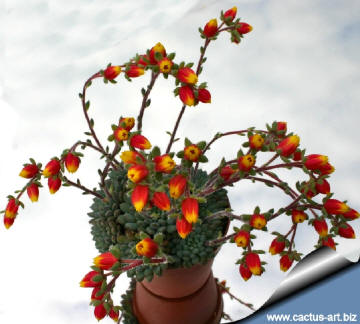
Easy to grow and perfect for pots, it forms dense cushions
of neat, mediterranean-blue rosettes. |
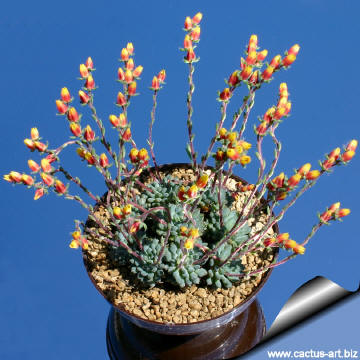 |
|
|
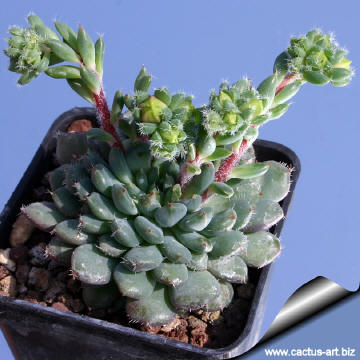 |
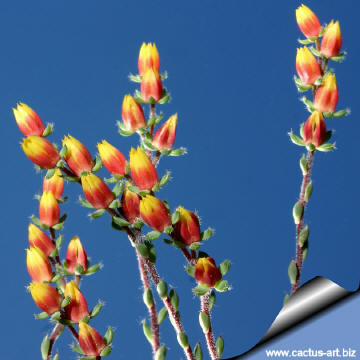 |
|
It has sky-blue, club-shaped
leaves with a tuft
of bristles at the
ends, the rosettes no bigger than about 3 cm, forming dense clusters. |
|


Advertising
|
|
|
|
|
Family:
Crassulaceae
Scientific name: Echeveria setosa var. deminuta Meyrán 1989
Common English Names include: Mexican Firecracker, Hens
and Chicks.
Origin: Southern Mexico, mountains of Oaxaca and
Puebla.
Etymology: The genus Echeveria is named after the 18th
century Spanish botanist Atanasio Echeverria Codoy.
The species name “setosa” comes from Latin “seta” =
“silk” refering to the leaves that are covered by glistening
silky hairs.
Synonyms:
- Echeveria Ciliata Moran
in: Repr. Cactus & Succ. Jour. 33: 131-140. 1961.A
- Echeveria setosa var. ciliata (Moran) Moran 1993
- Echeveria setosa var. minor Moran 1993
- Echeveria setosa var. oteroi Moran 1993
- Echeveria setosa var. setosa Rose & Purpus(1910
- Echeveria setosa var. deminuita "rundelii"
- Echeveria "rundelii"
Variety:
- E. setosa var. deminuta: (a.k.a. in
cultivation for some time as “E. rundelii”, or, “E.
tundelii”) It has tiny, blue, clubshaped
leaves with a tuft of bristles at the ends, the rosettes are no bigger
than about 3 cm. It form dense many headed clusters.
- E. setosa var. ciliata (a.k.a. E.
ciliata) It is a broader leaved plant, with somewhat fewer
bristles at the edges of the green leaves;
- E. setosa var. minor: It is a plant that combine the
best of the two previous forms, the leaves are covered with fine
bristles, it form a a pale blue flattish rosette about 8 cm wide.
NOTE: It has long been around in collections, and has widely
been used because of its dense, fuzzy covering of short, white hairs, to
produce several hybrids. The cross E. harmsii x E. setosa,
for example, produced Echeveria 'Set-Oliver', popular in
Britain. Other crosses elsewhere resulted in Echeveria 'Herzblut'
in Germany and Echeveria 'Doris Taylor' in California, to
name but a few. Crested clones are also known and highly valued by many
collectors.
|
|
|
|
Cultivation: Echeveria are
easily grown succulents that can tolerate sun, shade, moist soils, dry
soils, but look their best only when given adequate light levels and
water, and ideally should be grown outdoors in full sun. Generally
speaking, the more light a plant gets the better it will display its
colours and shape. Bright light is required to prevent "stretching" of
Echeverias ("stretching" occurs when a moderately fast growing plant
such as an Echeveria, is grown in dim light or over-fertilized, which
causes overly lush growth that contributes to weak, pallid plants).
However, when moving plants from lower light conditions into full sun,
be wary of sun scorch resulting from too rapid a transition into intense
summer sunlight, most easily avoided by ensuring plants are well-watered
before moving them on a cloudy day. Echeveria are able to tolerate
extended dry periods and survive drought without the need for watering,
but they will grow stronger if they receive adequate moisture during
their growing season, but never allowing the plant to remain waterlogged
(root rot sensitive). For this reason, it is essential in cultivation to
use a very porous soil, which will allow quick drainage. Avoid overhead
watering under humid conditions, especially during winter. Echeveria are
shallow rooted plants, and therefore benefit from good levels of organic
matter in the soil. Give it enough root space for optimum growth. Slow
release fertilisers with a low to moderate nitrogen content incorporated
into the potting mix are usually adequate for the spring and summer
growing seasons of Echeveria, and additional fertiliser applications
would not normally be required until spring. Good air movement is
important for minimising pest and disease risks, and avoiding excessive
humidity in cool winter conditions is important to successfully growing
Echeveria in the nursery environment. Can tolerate light frosts.
however, the ideal temperature range during the summer growing season is
5-25°C, with the cooler autumn temperatures tending to make their
foliage colours become more intense than those of the active summer
growing season. Aphids like this plant (and all flowering Echeverias).
Propagation: It is easily propagated by cuttings in the spring.
When the stem becomes too tall, just cut the top
rosette with a piece of stem and plant it. It will soon take root, while
the plant left with just the stem will soon grow new buds that can be in
turn used for propagation. Time to take cuttings: April to July. It may
also propagated by
leaf propagation. If the plant is
repotted some of the bottom
leaves can be removed, in order to attempt propagation..
However some of the
cuttings will dry out without producing a
plantlet.
Photo of conspecific taxa, varieties, forms and
cultivars of Echeveria setosa.
|
|